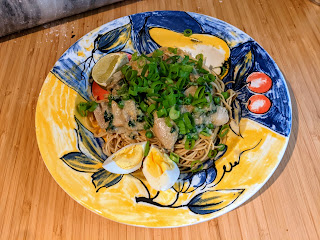I can't say I was thrilled with the results of this first attempt. I found the batter slightly too thick and they weren't quite as bubbly as I'd hoped. I also had the pan much too hot! They burned on the bottom before they were anywhere near cooked through. That said, I'd be willing to give this recipe another go now that I've dialed in the cooking temperature.
Sourdough Crumpets
Slightly adapted from Sourdough.com
Ingredients
Directions
- Weigh flour into a 1L measuring cup.
- Add starter and water and mix with a chopstick.
- Add sugar and salt and mix with a chopstick.
- Cover and leave in a cool place overnight3.
- Preheat a cast iron frying pan/griddle over low heat.
- Grease your pan and your crumpet/egg rings.
- Place the greased rings in the pan and fill each one halway with batter. Pour the batter rather than scooping/ladeling it so as not to deflate it.
- Cook for 5-7 minutes.
- Remove the rings, cover the pan, and cook for another 2-3 minutes.
- Flip the crumpets and cook for 1 more minute.
- Toast and slather with butter (and optionally jam).
1 I used hard whole wheat flour, but I'd be inclined to try it with all-purpose flour next time. Back
2 For white flour, use the lesser amount of water. For whole wheat flour, use the greater amount. Back
3 You may need to adjust the timing based on how active your starter is and how warm/cold your "cool place" is. I found that 12 hours was about right for a batter with a very active starter kept in a cool basement (~16°C) overnight. For less active starter and/or cooler temperatures, you'll need to give it more time. Warmer temperatures (or more active starters) will need less time. Back



















